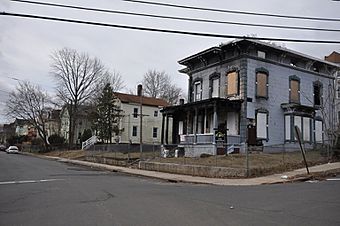Walnut Hill District facts for kids
Quick facts for kids |
|
|
Walnut Hill District
|
|
 |
|
| Location | Irregular pattern roughly bounded by Hart, Arch, West Main and Lake Sts., and Walnut Hill Park, New Britain, Connecticut |
|---|---|
| Area | 36 acres (15 ha) |
| Built | 1840 |
| Architect | Briggs, Warren; Et al |
| Architectural style | Gothic, Queen Anne, Italianate |
| NRHP reference No. | 75001936 |
| Added to NRHP | September 2, 1975 |
The Walnut Hill District is a special historic area in New Britain, Connecticut. It's mostly a neighborhood with old houses. This district shows how the city grew as a place where many factories made tools between 1840 and 1930. It's located southwest of downtown New Britain, near Walnut Hill Park. This important area was added to the National Register of Historic Places in 1975.
Contents
Exploring the Walnut Hill District
New Britain started as a farming town. It was part of other towns like Berlin and Farmington. In 1850, New Britain became its own separate city.
New Britain's Industrial Growth
The city's history changed with small metalworking shops. These shops grew bigger and bigger. Soon, New Britain became a top place for making tools in the country. This growth brought many people to live and work here.
Homes and Architecture
The Walnut Hill neighborhood is located between downtown New Britain and Walnut Hill Park. This park was once a water supply, but it became a public park in the 1860s. The neighborhood has many different styles of houses. Most of them were built between 1840 and 1930.
Most houses are made of wood. They are similar in size and are placed on similar-sized lots. This makes the area feel connected, even with all the different house styles.
Architectural Styles You Can See
The most common house style you will find is the Italianate style. This style was popular when New Britain was growing fast in the 1850s and 1860s. One great example is the David Nelson Camp House. It is located at 9 Camp Street.
Other styles include Gothic and Queen Anne. These styles show the different times the neighborhood grew. The district includes 145 main buildings that are important to history.



